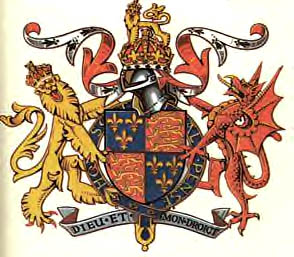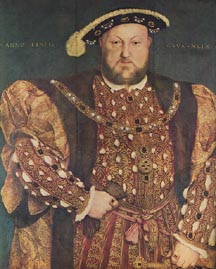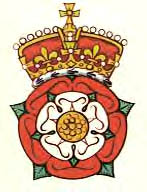
Henry VIII and His Six Wives
Written and researched by: Margaret Odrowaz-Sypniewska, B.F.A.

 .....
.....
Music playing is Henry VIII's Pastime in Good Company" ... My midi is from The Internet Renaissance Band
I have always been fascinated with Henry VIII. He was one of the most written about monarchs in English history. In his quest for heirs, he divorced Catharine of Aragon (who gave him his first daughter, Mary Tudor, later known as "Bloody Mary"), He beheaded his second wife, Ann Boleyn (who bore him Elizabeth Tudor, Elizabeth I, "the Virgin Queen"). His third wife, Jane Seymour, finally gave him his son, Edward, but Jane died in childbirth and her son had a very short reign as king. Henry saw a portrait of Ann of Cleves, and decided that she might be a good fourth wife, but later discovered that her portrait flattered her, and their marriage was annulled. Henry quickly married and beheaded Catharine Howard, Anne Boleyn's first cousin, and his fifth wife. In his old age, he married Katharine Parr. She who married a series of old men, and outlived Henry VIII, before giving birth or being left or executed like all the rest. She ended up raising his children. Henry Tudor (Henry VIII) certainly didn't get his heir. Not even his illegitimate children lived to carry on his line. Thus, we can pretty much establish that Henry VIII did not leave a single heir (at least not that we know of). There have been numerous stories about the possibility that Mary Boleyn (Anne's sister) might have given him an heir, but even Henry did not claim her children as his own. So we can't attest to any of this except as a new theory. I have included Henry VIII amongst my pages since he loved the Howards and Boleyns, and I have been searching to see if my lines connect to them, since I have multiple Howard lines in my Packard/Howard line. Some older records attested to this as truth, but modern genealogists say those old records were false. To date, I have NOT found a clear path connecting my Howards to the royal Howards.
I have read much about Henry since childhood and find him fascinating.
Henry VIII took the throne of England after the death of his father Henry VII on April 22, 1509. Henry was age eighteen (18). He was proclaimed "King" on April 23, 1509, the Feast Day of St. George, the patron saint of England and the Most Noble Order of the Garter.
Margaret and James had two children:
Henry was the youngest son, and was therefore was not in the limelight, as long as his brother Arthur was alive. His childhood was a rather isolated existence.
Mistresses of Henry VIII
In 1518, Henry (at age 27) tried Elizabeth "Bessie" Blount, the daughter of Shropshire knight, Sir John Blount of Kinlet Hall in Shropshire, England. Her mother was Katherine Peshall. Katerine's father fought at Bosworth with Henry VII. John and Katherine Blount had a total of eleven children. Bessie was eighteen years old at the time Henry met her, and was said to be a real beauty. In the summer of 1519, Bessie gave birth to Henry's son in Blackmore Manor (alias "Jericho") in Essex, England. Jericho was one of two houses of pleasure where Henry kept for his whores. The child, Henry Fitzroy (1519-1536) was made the Duke of Richmond on June 15, 1524 (at age 6) and one week earlier he was made Knight of the Garter.
The title of Duke of Richmond was the title Henry VIII's father had before becoming King of England. Henry Fitzroy was raised as the son of Bessie's husband, Gilbert Tailboys at Rokeby Manor in Warwickshire. Gilbert Tailboys married Elizabeth Blount on June 1519. He was knighted in 1525. Bessie and Gilbert had three children before he died. Bessie's second husband was Edward Fiennes, 9th Lord Clinton, Earl of Lincoln. Edward was fourteen years older than Elizabeth Blount. She bore him three daughters and she died in 1540. Bessie's son, Henry FitzRoy, was given a dowry. Henry, Jr. died of tuberculosis, in his teens (age 17), on July 22, 1536, in St. James Palace, and was buried in St. Michael's Church in Framlingham. In 1533, Henry Fitzroy married Mary Howard, the daughter of Thomas, Duke of Norfolk and Anne, daughter of Edward IV. Mary's grandfather was Thomas Howard, Earl of Surrey and Second Duke of Norfolk (victor at Flodden). Mary's great-grandfather was John Howard, Duke of Norfolk and a knight at Bosworth in 1485.
It is thought that Henry and Mary never consummated their marriage before his early death.
Another mistress was Lady Elizabeth Fitzwalter (Henry's second cousin) who married Robert Fitzwalter.
Mary Boleyn, who Francois I, of France, dubbed "whore" was Henry's next love interest. He married her to: William Carey and she became Lady in Waiting to Catherine of Aragon. Their affair lasted two years.
Some think that Henry might have fathered one of her children. However, Henry never acknowledged her children as his. Mary Boleyn married (1) William Cary, the son of Thomas Cary of Chilton and Margaret Spencer (a descendant of Edward III). William was born c. 1495 and died on June 22, 1528. (2) Sir William Stafford was born c. 1512 and died June 22, 1528.
Children of William Carey were:
.....(A). Catherine Mary Carey who was born c. 1524 and died on January 15, 1569 in Hampton Court Palace. She was buried in Westminster Abbey on April 1569. Catherine Mary Carey married (1) Sir Frances Knolly, the son of Robert Knolly and Lettice Pennystone (1514-July 19, 1596).
.....(B). Henry Carey, Baron Hunsdon, was born March 4, 1526, and was said to have a remarkable resemblance to Henry VIII. Henry Carey died July 23, 1596 at Somerset House. Henry's marriage contract on May 21, 1545 was to Ann Morgan, daughter of Sir Thomas Morgan and Anne Whitney.
A child of Sir William Stafford was born about 1534 and died before they could be named.
The March 1999 issue of Genealogist Magazine explores the possibilty that Mary Boleyn's children were fathered by Henry VIII. The Society of Genealogists, in England, publishes this magazine.
Facts about Henry VIII
For more information about where famous people are buried, visit: Find a Grave
Henry VIII and the Reformation:
During the Reformation, Henry VIII was responsible for the destruction of many Catholic Church relics, and saint's remains. For example:
These saints also had two brothers named, Adlwulf and Adulphus. Their aunt was St. Hilda, the foundress and abbess of Whitby monastery. Queen Hereswide also entered a religious life after the death of King Anna and died a holy death in the abbey of St. Clotilde, near Paris.
St Etheldreda was contracted to marry Prince Tonbercht, who ruled a territory next to that of her father's. Her husband respected her vow of virginity. He died three years after their marriage and she was then a widow. She retired to the Isle of Ely, her settlement in her husband's will. She remained, in prayer, for the next five years. Later on, Etheldreda was made to marry King Egfrid, when he was only sixteen (16) years old. This was a political marriage and she remained chaste. They were married for twelve years and eventually King Egfrid allowed her to go into a monastery ruled by his aunt, Abbess Ebba, at Coldingham. She was given the veil by St. Wilfred in 671.
St. Etheldreda was an incorruptible. Her relics were scattered and the shrine was completely destroyed to the point that only the base remained. She was said to have prophesied her own death from the plague. She was buried in a wooden coffin, but sixteen years later her sister, Sexburga, removed her bones to the church. At this time her body was noted as free from corruption. The church was destroyed by the Danes, but her body was untouched. This was to continue for 800 years. When Henry VIII ordered the destruction of her body, only her left hand was said to have remained.
St. Cuthbert was an incorruptible. The King's commisioners, Dr. Lee, Dr. Henley, and Mr. Blythman, were sent in the year 1537 to Durham to destroy the shrine and relics of this saint. It this time there were jewels and gold chalices that were taken as well. Henry's men were surprised to see that the body was incorrupt as were his vestments. They carried the body to the vestry, where it lay until the king could make a decision about the body's fate. Apparently, they feared that if they destroyed the body, there might be some sort of retributions to pay. Superstition saved St. Cuthbert. The priors and monks then buried him in the ground under the place where his shrine was exalted. A new grave was constructed in 1542. On May 17, 1827, the tomb was opened again and only the skelton remained. but his robes were intact. Many believe that this was not the real body of St. Cuthbert. The Benedictines were thought to have hidden the real body in case Henry VIII, or someone like him, would try to destroy the body again. In 1537, the body had been incorrupt for eight hundred and fifty years.
MORE TUDOR LINKS:
Tudor History ...
The Mary Rose ...
Tudor Web
Holbein, Hans the Younger ... Artcult-Hans Holbien ... See MY BIBLIOGRAPHY under Royalty for my sources.

HENRY VII's CHILDREN WERE:
All of her four sisters were saints:
Tudor Table
Home